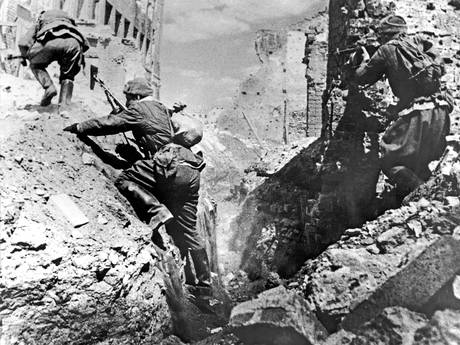We should never forget – the Soviets won World War II in Europe
In the Western popular imagination — particularly the American one — World War II is a conflict we won. It was fought on the beaches of Normandy and Iwo Jima, through the rubble of recaptured French towns and capped by sepia-toned scenes of joy and young love in New York. It was a victory shaped by the steeliness of Gen. Dwight D. Eisenhower, the moral fiber of British Prime Minister Winston Churchill, and the awesome power of an atomic bomb.
But that narrative shifts dramatically when you go to Russia, where World War II is called the Great Patriotic War and is remembered in a vastly different light.
On 9 May, Russian President Vladimir Putin played host to one of Moscow’s largest ever military parades to mark the 70th anniversary of the Soviet Union’s victory over Nazi Germany. More than 16,000 troops participated, as well 140 aircraft and 190 armored vehicles, including the debut of Russia’s brand new next-generation tank.
It was a grand moment, but few of the world’s major leaders attended. The heads of state of India and China will look on, but not many among their Western counterparts. That is a reflection of the tense geopolitical present, with Putin’s relations with the West having turned frosty after a year of Russian meddling in Ukraine. When Russia’s T-14 Armata tank broke down at a parade rehearsal on 7 May, the snickering could be heard across Western media.
Unfairly or not, the current tensions obscure the scale of what’s being commemorated: Starting in 1941, the Soviet Union bore the brunt of the Nazi war machine and played perhaps the most important role in the Allies’ defeat of Hitler. By one calculation, for every single American soldier killed fighting the Germans, 80 Soviet soldiers died doing the same.
Of course, the start of the war had been shaped by a Nazi-Soviet pact to carve up the lands in between their borders. Then Hitler turned against the U.S.S.R.
The Red Army was “the main engine of Nazism’s destruction,” writes British historian and journalist Max Hastings in “Inferno: The World at War, 1939-1945.” The Soviet Union paid the harshest price: though the numbers are not exact, an estimated 26 million Soviet citizens died during World War II, including as many as 11 million soldiers. At the same time, the Germans suffered three-quarters of their wartime losses fighting the Red Army.
“It was the Western Allies’ extreme good fortune that the Russians, and not themselves, paid almost the entire ‘butcher’s bill’ for [defeating Nazi Germany], accepting 95 per cent of the military casualties of the three major powers of the Grand Alliance,” writes Hastings.
The epic battles that eventually rolled back the Nazi advance — the brutal winter siege of Stalingrad, the clash of thousands of armored vehicles at Kursk (the biggest tank battle in history) — had no parallel on the Western Front, where the Nazis committed fewer military assets. The savagery on display was also of a different degree than that experienced farther west.
Hitler viewed much of what’s now Eastern Europe as a site for “lebensraum” — living space for an expanding German empire and race. What that entailed was the horrifying, systematic attempt to depopulate whole swaths of the continent. This included the wholesale massacre of millions of European Jews, the majority of whom lived outside Germany’s pre-war borders to the east. But millions of others were also killed, abused, dispossessed of their lands and left to starve.
massacre of millions of European Jews, the majority of whom lived outside Germany’s pre-war borders to the east. But millions of others were also killed, abused, dispossessed of their lands and left to starve.
The Holocaust overshadows German plans that envisioned even more killing. Hitler wanted not only to eradicate the Jews; he wanted also to destroy Poland and the Soviet Union as states, exterminate their ruling classes, and kill tens of millions of Slavs,” writes historian Timothy Snyder in “Bloodlands: Europe between Hitler and Stalin.”
By 1943, the Soviet Union had already lost some 5 million soldiers and two-thirds of its industrial capacity to the Nazi advance. That it was yet able to turn back the German invasion is testament to the courage of the Soviet war effort. But it came at a shocking price.
In his memoirs, Eisenhower was appalled by the extent of the carnage:
”When we flew into Russia, in 1945, I did not see a house standing between the western borders of the country and the area around Moscow. Through this overrun region, Marshal Zhukov told me, so many numbers of women, children and old men had been killed that the Russian Government would never be able to estimate the total.
To be sure, as Snyder documents, the Soviet Union under Stalin also had the blood of millions on its hands. In the years preceding World War II, Stalinist purges led to the death and starvation of millions. The horrors were compounded by the Nazi invasion.
“In Soviet Ukraine, Soviet Belarus, and the Leningrad district, lands where the Stalinist regime had starved and shot some four million people in the previous eight years, German forces managed to starve and shoot even more in half the time,” Snyder writes. He says that between 1933 and 1945 in the “bloodlands” — the broad sweep of territory on the periphery of the Soviet and Nazi realms — some 14 million civilians were killed.
By some accounts, 60 percent of Soviet households lost a member of their nuclear family.
For Russia’s neighbors, it’s hard to separate the Soviet triumph from the decades of Cold War domination that followed. One can also lament the way the sacrifices of the past inform the muscular Russian nationalism now peddled by Putin and his Kremlin allies. But we shouldn’t forget how the Soviets won World War II in Europe.
Copyright: Washington Post
The Independent
M.W

